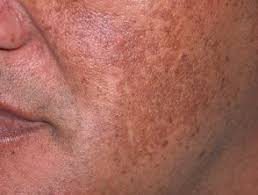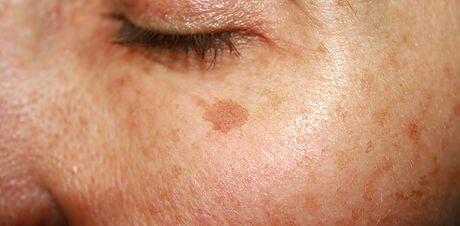Melasma is the most common purchased hyperpigmentation in women. Melasma affects mainly areas exposed to ultraviolet radiation: in particular the forehead, cheeks, temples and upper lip. This negatively affects the psychological state and quality of life of patients. Ultraviolet radiation is one of the main etiological factors of melasma. Currently, aesthetic medicine offers many ways to correct hyperpigmentation, both for home use and salon procedures.
This article on estet-portal.com compares two topical agents, hydroquinone and silymarin, which have been successfully used as tropical agents to combat melasma.
Melasma treatment overview
UV-induced hyperpigmentation occurs due to increased activity of melanocytes and lipid peroxidation of the cell membrane with the production of free radicals that stimulate the production of melanin in abundance. It has been suggested that oxidative stress plays an important role in the pathogenesis of melasma. Various antioxidant agents use substances such as vitamin E, niacinamide, and vitamin C in the treatment of melasma, especially because of their inhibitory effect on free radicals that trigger melasma.
Melasma treatment: an overview of methods.
Silymarin is derived from spotted milk thistle. Silibinin, the main component of silymarin, has a strong antioxidant effect. Silymarin neutralizes the harmful effects of ultraviolet radiation and prevents the formation of hyperpigmentation.
Hydroquinone (HQ) is the most popular and most studied drug for the treatment of melasma and hyperpigmentation. It inhibits melanogenesis by inhibiting the tyrosinase enzyme, affects the formation, melanization and degradation of melanosomes, and modulates the membrane structures of melanocytes, causing necrosis of whole melanocytes. However, hydroquinone is associated with frequent side effects that stimulate research into other drugs.

The aim of this study was to compare the efficacy and safety of silymarin at two different concentrations (0.7% and 1.4%) versus standard hydroquinone 4% in the treatment of melasma. This is the first study comparing these two different agents in the treatment of hyperpigmentation. The severity of melasma, as assessed by the MASI scale, significantly decreased after treatment with silymarin cream in both groups. Although the concentration of silymarin in group 2 (1.4%) was twice as high as in group 1 (0.7%), there was no statistically significant difference in therapeutic response between both groups. This indicates that low concentration silymarin may be better than higher concentrations in terms of cost and side effects.
Moreover, silymarin compared to intradermal injections of tranexamic acid and glycolic acid in the form of peeling, also shows higher efficiency.
Melasma treatment with tranexamic acid.
In the study, 46 patients with melasma were divided into three groups. The first group received 0.7% silymarin cream, the second group received 1.4% silymarin cream and the third group received 4% hydroquinone cream. Silymarin was applied twice daily and hydroquinone once daily at night. The duration of treatment in the 3 study groups was 3 months.
All patients were advised to avoid excessive sun exposure and to apply a broad-spectrum sunscreen with a sun protection factor of at least 50. Color digital photographs were taken at baseline and every 2 weeks at
At Baseline Mean MASI Score in Group 1 was 18.56 ± 5.58, after 1 month it decreased to 13.94 ± 4.92, after 2 months it became 12.62 ± 4.76, at the end of treatment became 10.96 ± 4.48%, and % reduction in MASI the post-treatment score was 39.21 ± 20.65.
Peculiarities of using peeling for the treatment of melasma.
In the second group (silymarin cream 1.4%)At baseline, the mean MASI score was 21.75 ± 8.47, after 1 month decreased to 17.39 ± 8.07, after 2 months it became 15.6 ± 7.92, at the end of treatment - 14.88 ± 7.79%, and % reduction in MASI. score after treatment was 33.84 ± 15.61.
In the third group (hydroquinone cream 4%)

At baseline, the mean MASI score was 16.64 ± 9.0, after 1 month decreased to 12.25 ± 6.94, after 2 months it became 10.82 ± 7.10, at the end of treatment he became 8.81 ± 5.68%, and the percentage reduction in the MASI after treatment was 46.75 ± 22.83.
A statistically significant decrease in MASI was observed in the same group. Although the percentage reduction in MASI score was slightly higher in the hydroquinone group, no statistically significant difference in MASI score was found between the three study groups.
There was a statistically significant difference in reported side effects between the hydroquinone and silymarin groups.
Hydroquinone was associated with erythema in 10 patients (71.4%), burning in 10 patients (71.4%), scaling in 10 patients (71.4%), with no side effects found in both silymarin groups.
The exact mechanism of action of silymarin has not yet been fully elucidated.
Silibinin, the main component of silymarin, has powerful antioxidant and photoprotective effects, minimizing the harmful effects of UV radiation such as oxidative stress, inflammation, edema, erythema, DNA damage and immune responses.
Silymarin can also reduce melanin production due to its antioxidant effect and inhibition of tyrosinase activity to oxidize L-dopa. In addition, it was found that silymarin reduces the expression of
protein tyrosinase. Conclusion
Thus, topical silymarin is an effective and safe treatment for melasma and may represent a promising alternative to conventional hydroquinone. For best results, longer therapy is recommended. Further studies with a larger number of patients and long-term follow-up are recommended to confirm these results.







Add a comment